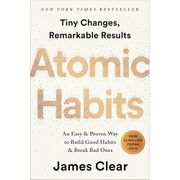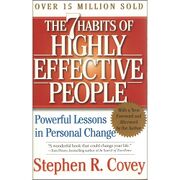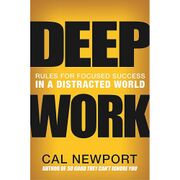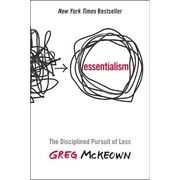Grit
🍎 Healthy brain food
"As much as talent counts, effort counts twice."
— Angela Duckworth, Grit (2016)
Introduction
| Grit | |
|---|---|
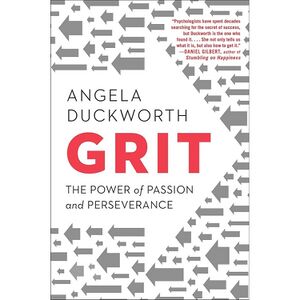 | |
| Full title | Grit: The Power of Passion and Perseverance |
| Author | Angela Duckworth |
| Language | English |
| Subject | Success; Perseverance (Ethics); Psychology |
| Genre | Nonfiction; Self-help |
| Publisher | Scribner |
Publication date | 3 May 2016 |
| Publication place | United States |
| Media type | Print (hardcover, paperback); e-book; audiobook |
| Pages | 333 |
| ISBN | 978-1-5011-1110-5 |
| Goodreads rating | 4.1/5 (as of 6 November 2025) |
| Website | simonandschuster.com |
📘 Grit: The Power of Passion and Perseverance is a nonfiction book by psychologist Angela Duckworth that blends research and reportage to argue that sustained passion and effort—“grit”—drive long-term achievement. Duckworth defines grit in the scholarly literature as “perseverance and passion for long-term goals,” drawing on studies of West Point cadets, National Spelling Bee contestants, and other cohorts. The book introduces an “effort counts twice” equation (talent × effort = skill; skill × effort = achievement) and organizes practical guidance around interest, deliberate practice, purpose, and hope.[1] Written in an accessible, reportorial style that mixes case studies and psychology, the prose explains findings and offers practical advice.[2] The hardcover is structured in three parts—what grit is and why it matters; growing grit from the inside out; and growing grit from the outside in—with a concluding chapter.[3] On release in May 2016, it was billed by the publisher as an “instant New York Times bestseller” and debuted at #2 on Publishers Weekly’s Hardcover Nonfiction list (week of 16 May 2016).[4]
Chapter summary
This outline follows the Scribner hardcover first edition (3 May 2016; ISBN 978-1-5011-1110-5).[5][6]
I – What Grit Is and Why It Matters
🚪 1 – Showing Up. At the U.S. Military Academy at West Point, newcomers face “Beast Barracks,” a seven-week gauntlet that begins before dawn and ends with Taps around 10 p.m., compressing each day into drills, academics, and inspections. Admission rides on the Whole Candidate Score—a weighted blend of SAT/ACT results, class rank adjusted for cohort size, leadership appraisals, and objective physical tests—plus a nomination from a member of Congress or the vice president. Despite such screening, about one in five cadets will leave before graduation, many during Beast’s first summer. In July 2004, on the second day of Beast, the new class completed the self-report Grit Scale alongside the standard metrics. West Point’s composite score predicted grades and military/fitness marks, yet it could not reliably forecast who would endure Beast. Grit scores, in contrast, tracked who stayed through the summer’s demands, over and above test scores or athletic measures. A ninety-second goodbye to parents, shaved heads, footlockers, and issued gear underline how little comfort or autonomy newcomers have. The lesson is not that talent or fitness are irrelevant, but that they fail to capture day-after-day follow-through under stress. Endurance of effort under uncertainty—showing up, again and again—explains completion better than any snapshot of ability. Through sustained attention and self-regulation, grit channels motivation into consistent action across discomfort, which is why persistence, not pedigree, predicts survival in Beast.
🌟 2 – Distracted by Talent. At twenty-seven, a former management consultant trades a midtown glass tower for a seventh-grade math classroom on Manhattan’s Lower East Side. “Quick studies” who saw patterns at once did not necessarily earn the top marks; steadier classmates who asked questions, took notes, and came for extra help rose fastest. A move to San Francisco’s selective Lowell High School revealed the same pattern: many teens studied for hours a day, and a quiet striver, David Luong, advanced into the accelerated track. After early setbacks—including a low test grade—he sought help, persisted, earned a 5 on AP Calculus, and ultimately built an engineering career. In 1869 Francis Galton argued that achievement blends ability, “zeal,” and “capacity for hard labor,” while Charles Darwin emphasized zeal and hard work over intellect in a famous letter. Experiments on “naturalness bias” show that evaluators rate the same performance more favorably when they think it comes from a “natural” rather than a “striver,” in music and entrepreneurship alike. That bias tempts schools and companies to overrate sparkle and underrate stamina, mistaking promise for performance. The point is not to deny innate differences but to notice how a fixation on talent blinds observers to the processes that produce results. By elevating practice, persistence, and long-horizon commitment, grit reframes selection and development around behaviors that compound, not impressions that fade. Sustained effort thickens skill through repetition and then applies that skill to consequential tasks; when attention drifts to “naturals,” both loops stall.
🔁 3 – Effort Counts Twice. In 1940 at Harvard, 130 sophomores ran a steep, fast treadmill test capped at five minutes; the average lasted about four minutes, and some stepped off after ninety seconds. Decades later, psychiatrist George Vaillant’s follow-up showed that longer run times at age twenty predicted better psychological adjustment across adulthood even after accounting for baseline fitness. The pattern echoes a popular “treadmill” metaphor: accomplishment favors the one who refuses to step off. To make the intuition precise, the book sets out two equations—talent × effort = skill, and skill × effort = achievement. Because effort builds skill and then makes that skill productive, the same native ability with more effort yields far more output over time. Dan Chambliss’s “The Mundanity of Excellence” supports this logic: elite swimmers’ dominance comes from thousands of ordinary, correctly executed actions compounded across years. Examples contrast “naturals” with strivers like novelist John Irving, who rewrote relentlessly despite dyslexia, to show how daily practice transforms capacity. Consider master potter Warren MacKenzie: more hours at the wheel increased both the number of pots and the share he judged “good,” illustrating how practice expands skill and the volume of meaningful work. The dynamic is compounding: consistent, directed effort nudges learning curves upward and simultaneously converts yesterday’s gains into today’s results. Grit keeps the effort term alive in both equations long enough for achievement to snowball. With effort, talent becomes skill and, at the very same time, effort makes skill productive.
🧪 4 – How Gritty Are You? At the U.S. Military Academy at West Point, incoming cadets complete psychological questionnaires during the first days of Beast Barracks, alongside physical and academic assessments; among them is the self-report Grit Scale. Built and later refined into the eight-item Grit-S, the inventory asks people to rate statements such as “Setbacks don’t discourage me” and “New ideas and projects sometimes distract me from previous ones” on a five-point scale from “Very much like me” to “Not like me at all,” with half the items reverse-scored so the averaged result falls between 1.0 and 5.0. Across cadet cohorts, grit predicts who finishes Beast even after accounting for the Whole Candidate Score, which bundles test scores, class rank, leadership ratings, and fitness measures. In another validation, Scripps National Spelling Bee finalists with higher grit report more hours of deliberate practice and tend to advance further in competition. The scale distinguishes perseverance of effort from consistency of interests, and many respondents find their effort scores outpace their consistency, a practical clue to where progress stalls. Computing one’s own score and comparing it across age and experience can be informative. The broader point is that a simple, well-tested measure can reveal the behavioral patterns—sticking with things and staying in love with them—that aptitude tests miss. By translating passion and perseverance into a number tied to real outcomes, grit turns attention from flashes of promise to sustained follow-through.
🌱 5 – Grit Grows. Large cross-sectional surveys using the Grit Scale show a modest, reliable pattern: older adults tend to score higher than younger adults, even when education is held constant. Two explanations fit the data: historical context may shape cohorts differently, and individuals may mature toward greater perseverance as they accumulate experience and responsibility. Personality science calls this the “maturity principle,” and snapshots across ages cannot, by themselves, prove change within a person. Interviews with high achievers—from athletes to artists—trace a similar arc: years of exploration, then narrowing commitments, then decades of steady pursuit through setbacks. Field studies at West Point and the National Spelling Bee reinforce that people who keep returning after early failures are the ones who stay the course. Align daily tasks to a small set of higher-order goals so effort compounds instead of scattering. In practice, prune distractions, schedule practice, and let time do its quiet work. Grit strengthens when environments reward long-horizon choices and when habits make it easier to come back the next day. As meaning deepens and small wins accrue, persistence stabilizes interest, creating a loop in which sticking with it becomes easier and more natural.
II – Growing Grit from the Inside Out
🔍 6 – Interest. Drawing on Benjamin Bloom’s multi-year research on world-class performers, a three-phase path emerges: early years of playful discovery, middle years of disciplined practice, and later years of purpose-driven work. Early sparks usually come from exposure—trying a school instrument, joining a robotics club, or taking a weekend class—while stakes are low and encouragement is high. Parents and mentors keep curiosity alive by supplying materials, feedback, and room to tinker rather than dictating a single track. Studies in sport and music echo this pattern: broad sampling before specialization reduces burnout and preserves intrinsic motivation, which matters when training turns demanding. As commitment grows, novices shift to purposeful practice—clear stretch goals, full concentration, immediate feedback, and repetition with reflection—so skill advances even when sessions feel effortful rather than fun. Over time, many come to see their work as contributing beyond themselves, and that sense of purpose steadies attention when novelty fades. The practical counsel is to protect play at the start, then layer structure as interest matures. Interest fuels perseverance because enjoyment makes effort self-sustaining over years. By letting fascination lead and then engineering deliberate practice around it, grit converts a first spark into a durable passion that can withstand tedium, frustration, and plateau.
🛠️ 7 – Practice. At the Scripps National Spelling Bee in 2006, 190 finalists were followed in a Penn study showing that the competitors who spent more time in deliberate practice—solitary study and memorization—advanced further than peers who favored quizzing or leisure reading. Deliberate practice was rated the least enjoyable activity yet proved the strongest predictor of performance, and veterans gradually chose it more as they gained experience. Grit also tracked who accumulated more of this demanding work, and deliberate practice statistically explained how grit translated into better results. The method follows K. Anders Ericsson’s expert-performance template: define a narrow weakness, set a stretch goal, work with full concentration, get immediate, informative feedback, and repeat. Because deliberate practice targets errors, sessions feel like high-quality discomfort rather than effortless “flow,” which typically appears later in performance. The discipline of keeping score on tiny improvements turns hours into skill. The larger point is that practice doesn’t just add up; it compounds, because each corrected mistake makes the next correction faster. Tight feedback loops convert attention into skill and then skill into outcomes, so sustained, structured effort is where passion becomes measurable progress.
🎯 8 – Purpose. At a public university’s fundraising call center, a five-minute face-to-face with a scholarship recipient led callers, one month later, to spend about 142% more time on the phones and raise 171% more money; reading a letter alone did not move the needle. Making the beneficiary visible turned a rote job into work that mattered, and the effect replicated across semesters with different cohorts. In these pages, purpose means the intention to contribute to the well-being of others, and gritty people tend to braid that motive with personal interest. Amy Wrzesniewski’s research shows that people in any occupation can see their work as a job, a career, or a calling, and that calling often emerges by reframing daily tasks. Hospital cleaners who view themselves as part of patient care, for example, craft extra interactions with nurses and families and report more meaning without changing titles or pay. When goals connect to helping, persistence is less brittle because quitting would feel like letting others down, not just stepping away from a task. The practical move is to link routines to beneficiaries—students, clients, teammates—so significance stays in view when the work is tedious. Psychologically, vivid prosocial impact increases attention, energy, and endurance; behaviorally, it sustains the long haul that grit requires.
🌅 9 – Hope. In classic late-1960s experiments, Martin Seligman and Steven Maier exposed dogs to inescapable shocks; the next day many failed to jump a low barrier to safety even when escape was easy, a pattern they termed learned helplessness. Dogs that had previously controlled the shocks leapt the barrier quickly, showing that uncontrollability—not pain itself—erodes initiative. Here, hope is not wishful thinking but the expectation that one’s own efforts can improve the future, which makes trying again the default. Seligman’s later work brought that stance into practice with the ABC method—Adversity, Beliefs, Consequences—teaching people to dispute catastrophic explanations and test more specific, temporary ones. In a prospective study of roughly 390 novice teachers in under-resourced schools, measures taken before the school year showed that grit and life satisfaction predicted student academic gains more robustly than traditional credentials, aligning resilient outlooks with real classroom impact. Growth-mindset research complements this by showing that believing abilities can improve keeps setbacks contained and surmountable. In effect, explanatory style governs whether effort resumes after failure: temporary and specific stories invite action, permanent and pervasive stories shut it down. Grit needs this agentic hope to keep practice going after a fall, and hope needs repeated action to turn optimistic stories into results.
III – Growing Grit from the Outside In
👨👩👧 10 – Parenting for Grit. At home with Amanda and Lucy, a family ritual called the Hard Thing Rule sets expectations that everyone—including the adults—pursues a demanding activity that requires daily deliberate practice, that each person chooses their own pursuit, and that quitting is allowed only at a natural stopping point like the end of a season or a paid term. As the girls approach high school, the rule tightens: they must commit to one activity for at least two years so that interest and effort have time to compound. Stories from the household make the idea concrete—cycling through ballet, gymnastics, track, handicrafts, and piano before settling into viola, joining school and city orchestras, and noticing motivation grow as skill improves. Beyond one family, developmental research on parenting styles shows that children do best when adults are both demanding and supportive; a simple two-axis grid distinguishes authoritarian (high demand, low support), permissive (low demand, high support), neglectful (low both), and what Duckworth calls wise parenting (high both). Wise parents model follow-through, set clear expectations, and offer warmth and practical help, so that kids experience both accountability and belonging while they practice. Coaches and teachers can play the same role, bringing the same combination of standards and support to the gym, studio, or classroom. Autonomy over “your” hard thing preserves intrinsic motivation, while firm commitments create friction against impulsive quitting, so practice sessions add up. Over time, this blend turns scattered effort into stable identity, which is why wise, high-expectation care reliably grows grit.
🏟️ 11 – The Playing Fields of Grit. In a 1985 multi-campus study, Educational Testing Service researcher Warren W. Willingham tracked thousands of applicants and then 4,814 enrolled students across nine selective colleges, rating “productive follow-through” from extracurricular records; sustained, successful participation predicted college outcomes above grades and test scores. Building on that idea, Duckworth created a brief survey for high-school seniors that tallied multi-year commitment and advancement (awards or leadership) in up to two activities, then checked back two years later to see who was still in college. The pattern replicated: longer, deeper involvement—sticking with a sport, instrument, or club beyond a first year—went with persistence after high school. Youth sports and supervised arts programs serve as practical laboratories: a non-parent adult sets standards, practice is scheduled, feedback is immediate, and teams teach responsibility to others. Because rules, seasons, and competitions impose external structure, students learn to show up on hard days, not only on fun ones, and to keep effort consistent when progress slows. Parents can help by encouraging sampling early on, then asking for at least one multi-year commitment in adolescence so skills and identity have time to mature. The core point is that follow-through in real settings is both a proxy for grit and a way to build it; the same behaviors that predict later persistence are the ones that train it. Seasons, scoreboards, and teammates externalize goals and deadlines, converting self-control into shared routines that make perseverance easier to repeat.
🏛️ 12 – A Culture of Grit. After Seattle’s 2013 championship season, head coach Pete Carroll invited a close look at the Seahawks’ “Win Forever” program, where shared language (“Always Compete”), daily scripts, and film-room habits try to make improvement feel normal from rookies to front office. Meetings, drills, and even hallway slogans reinforce the identity of a group that expects effort and learning, not just talent, and veterans model how to review mistakes without panic. Similar cues appear in high-performing schools: posted norms, common routines, and a vocabulary for character—grit among them—make it easier for students to act as the culture expects. Goal hierarchies frame this idea: top-level “ultimate concerns” give meaning to mid-level strategies and daily tasks, so a workplace, team, or classroom can align hundreds of choices without micromanaging each one. Duckworth uses the Finnish word sisu to name the collective expectation to press on when conditions are rough, a trait leaders can cultivate by celebrating effortful progress and quick recoveries from setbacks. Culture works by default: people conform to the behaviors that seem normal for “us,” which is why joining a gritty group nudges individuals to become grittier. The practical takeaway is two-sided—seek out cultures whose values match long-term striving, and if you lead, design cues, rituals, and stories that make perseverance the path of least resistance. In effect, shared norms reduce the cost of effort, so passion and practice survive bad days and plateaus.
📘 Conclusion. The book closes with two avenues for growth: from the inside out—cultivating interests, scheduling deliberate practice, connecting work to a purpose beyond the self, and training an optimistic, agentic way of explaining setbacks—and from the outside in—surrounding yourself with parents, coaches, mentors, and teams that expect you to keep going. It recaps the evidence that grit predicts persistence in challenging, meaningful contexts and notes that grit is not the whole of character; virtues like honesty and kindness matter for the kind of life worth building. Practical tools return in brief: write a top-level goal and align mid-level plans; pick a hard thing and see it through; keep a feedback loop that turns errors into targets for the next session. The final notes are forward-looking: choose environments that reinforce commitments, use routines to protect daily effort, and measure progress by what you do repeatedly, not by how talented you looked at the start. The overall logic stays simple—effort builds skill, and effort deploys skill—so the compounding term is the one you control. In that spirit, the last pages invite a bias for action: begin, return tomorrow, and keep returning long enough for passion and perseverance to add up.
Background & reception
🖋️ Author & writing. Angela Duckworth is a professor of psychology at the University of Pennsylvania whose research focuses on grit and self-control.[7] She received a MacArthur Fellowship in 2013.[8] The academic foundation for the book is her work defining grit and testing it across populations such as West Point cadets and National Spelling Bee contestants. The publisher describes the book as weaving personal narrative with field studies in schools, the military, and competitive settings. The first edition presents a three-part structure (definition and importance; growing grit from the inside out; growing grit from the outside in) that frames the reportage-plus-science voice.[3][2] Duckworth also co-founded Character Lab in 2013 to translate research into practice through school-based studies and online “Playbooks.”[9] Character Lab later announced it would sunset operations in June 2024.[10]
📈 Commercial reception. Publishers Weekly reported that Grit debuted at #2 on its Hardcover Nonfiction list for the week of 16 May 2016.[4] Simon & Schuster describes the title as an “instant New York Times bestseller.” A trade paperback edition followed on 21 August 2018.[11] An audiobook narrated by the author was released by Simon & Schuster Audio.[12]
👍 Praise. Publishers Weekly called the book “an informative and inspiring contribution to the literature of success.”[1] Kirkus Reviews described it as an accessible blend of anecdote and science and “a pleasure to read.”[2] In The Washington Post, Sarah Carr judged it a useful guide for parents and teachers, summarizing its emphasis on interest, practice, purpose, and hope.[13]
👎 Criticism. David Denby in The New Yorker argued that Grit overstates a single trait and can neglect structural factors such as poverty and opportunity.[14] Jerry Useem in The Atlantic highlighted downsides of dogged persistence and cautioned against elevating grit above other skills.[15] A 2017 meta-analysis questioned grit’s distinctiveness from conscientiousness and found modest links to performance outcomes.[16] The Harvard Graduate School of Education also summarized concerns that a grit focus can “blame the victim” by downplaying systemic barriers.[17]
🌍 Impact & adoption. Duckworth’s 2013 TED Talk, “Grit: the power of passion and perseverance,” has been widely viewed and helped popularize the concept beyond academia.[18] KIPP’s Character Growth Card incorporated “grit” among seven character strengths used for feedback in schools.[19] In research settings, noncognitive attributes including grit have predicted completion of intensive initiation training and four-year graduation among West Point cadets.[20] At the same time, large U.S. districts (the CORE network in California) pursued SEL measurement focusing on constructs such as growth mindset, self-efficacy, self-management, and social awareness rather than grading “grit,” reflecting cautions Duckworth herself has voiced about high-stakes use.[21][17]
Related content & more
YouTube videos
CapSach articles
Enjoyed this page?
📚If this page Grit inspired or helped you today, a small coffee helps us keep creating and sharing more. Your support truly matters.👏
References
- ↑ 1.0 1.1 "Grit: The Power of Passion and Perseverance". Publishers Weekly. 21 March 2016. Retrieved 3 November 2025.
- ↑ 2.0 2.1 2.2 "GRIT". Kirkus Reviews. 7 March 2016. Retrieved 3 November 2025.
- ↑ 3.0 3.1 "Grit: the power of passion and perseverance — Table of contents". Colorado Mountain College (Marmot Library Network). Retrieved 3 November 2025.
- ↑ 4.0 4.1 "This Week's Bestsellers: May 16, 2016". Publishers Weekly. 13 May 2016. Retrieved 3 November 2025.
- ↑ "Grit (Hardcover)". Simon & Schuster. Simon & Schuster. 3 May 2016. Retrieved 6 November 2025.
- ↑ "Library of Congress Catalog Record: Grit : the power of passion and perseverance". Library of Congress Online Catalog. Library of Congress. Retrieved 6 November 2025.
- ↑ "Angela Duckworth". University of Pennsylvania, Department of Psychology. Retrieved 3 November 2025.
- ↑ "Angela Duckworth". MacArthur Foundation. 25 September 2013. Retrieved 3 November 2025.
- ↑ "About Character Lab". Character Lab. Retrieved 3 November 2025.
- ↑ "Character Lab — legacy site". Character Lab. Retrieved 3 November 2025.
- ↑ "Grit (Trade Paperback)". Simon & Schuster. Retrieved 3 November 2025.
- ↑ "Grit (Audio CD) — bibliographic record". Colorado Mountain College (Marmot Library Network). Retrieved 3 November 2025.
- ↑ Carr, Sarah (29 April 2016). "If you've heard the term grit lately, it's probably because of Angela Duckworth". The Washington Post. Retrieved 3 November 2025.
- ↑ Denby, David (21 June 2016). "The Limits of "Grit"". The New Yorker. Retrieved 3 November 2025.
- ↑ Useem, Jerry (May 2016). "Is Grit Overrated?". The Atlantic. Retrieved 3 November 2025.
- ↑ Credé, Marcus; Tynan, Michael C.; Harms, Peter D. (2017). "Much ado about grit: A meta-analytic synthesis of the grit literature". Journal of Personality and Social Psychology. 113 (3): 492–511. doi:10.1037/pspp0000102. Retrieved 3 November 2025.
- ↑ 17.0 17.1 "The Problem With Grit". Harvard Graduate School of Education. 8 April 2015. Retrieved 3 November 2025.
- ↑ "Grit: the power of passion and perseverance — TED-Ed lesson". TED-Ed. 9 May 2013. Retrieved 3 November 2025.
- ↑ "KIPP NYC's Approach to Character — Q&A" (PDF). KIPP. 2012. Retrieved 3 November 2025.
- ↑ Duckworth, Angela L.; Quirk, A.; Gallop, R.; Hoyle, R. H.; Kelly, D. R.; Matthews, M. D. (2019). "Cognitive and noncognitive predictors of success". Proceedings of the National Academy of Sciences. 116 (47): 23499–23504. doi:10.1073/pnas.1910510116. Retrieved 3 November 2025.
- ↑ "Measures of SEL and School Climate in California" (PDF). Policy Analysis for California Education (PACE). May 2020. Retrieved 3 November 2025.

